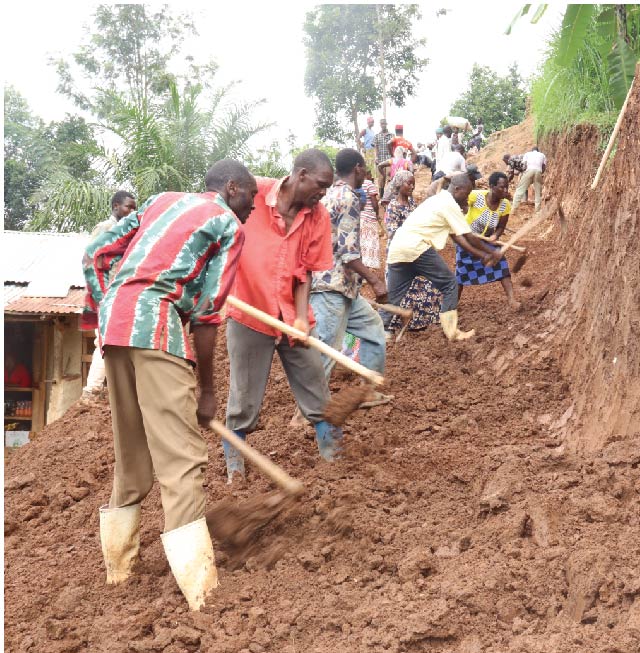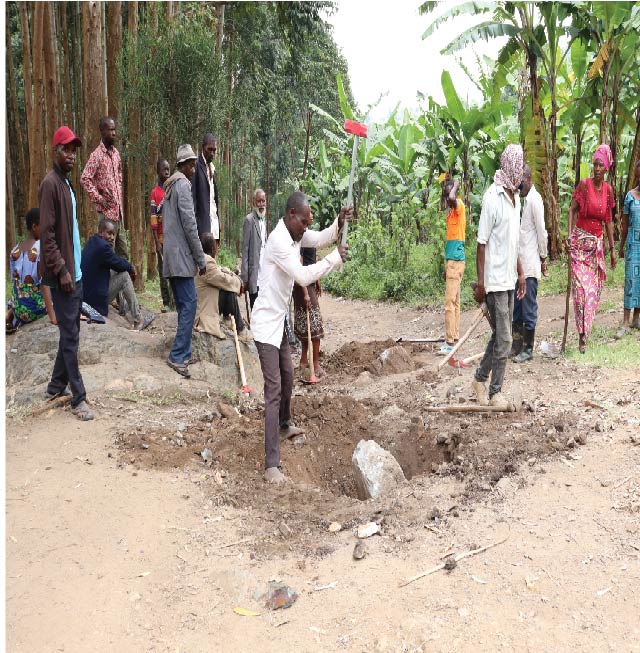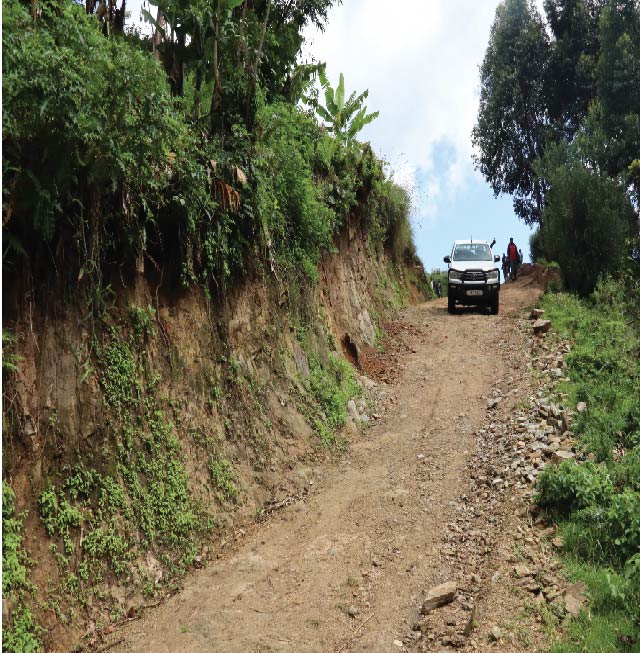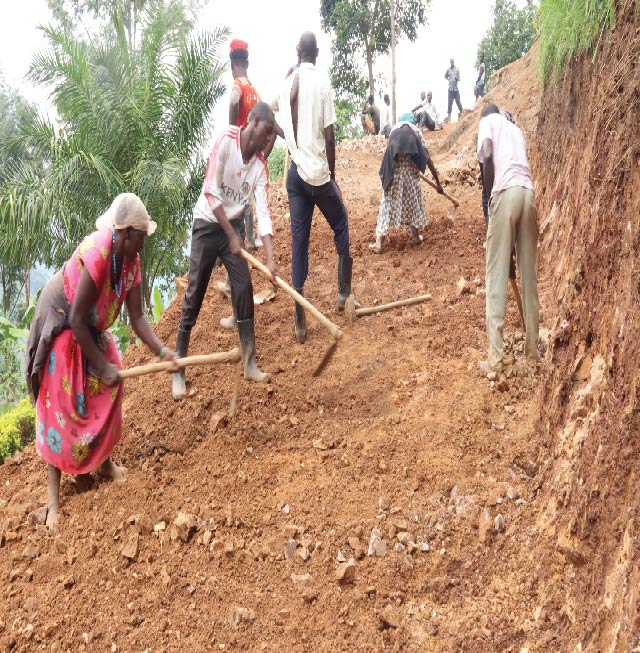CommonGround Communities Are Utilising Local Tools to Open Roads.
After an hour’s trek to Bufuma Hills on the slopes of Mt. Elgon in the Bududa district, we noticed a freshly opened, spacious, and immaculate road that appeared to have received substantial investment.
After a one kilometre walk down the road, around forty individuals, young and elderly, male and female, emerged. They were using different tools, such as hoes, pangas, forked hoes, heavy-duty harmers, and more, for road construction. While some people were moving soil and levelling the ground, others were excavating rocks from the road with a large hammer.
It is at this time that we learned that the community had collectively opened the entire community road, which we had been enjoying, and that they planned to keep working on it until it was connected to the main access road to Bududa town.
One of the locals mentioned that his community's lack of roadways had been causing problems. He said that the local authorities had informed them that opening roads would be challenging in their mountainous region. They were thus compelled to use their heads to carry the farm produce to the trading centres, from where they could get transportation to the markets.
In Bugarama-Bwanjojo community, Buhara Subcounty, Kabale District, also faced challenges in accessing hospitals and other facilities as well as transportation of farm produce. Because of the hilly nature, the locals would carry their farm produce on their heads, and as for the sick and expecting women, they would use temporary stretchers as a means of transport to health facilities.
According to Bugarama's PIP innovator, Resty Benkunda, roads were like dreams to the community. They relied on footpaths, occasionally carved by animals, for transportation. The situation was the same in Kariko community in Kitumba subcounty Kabale district. The area is well-known for producing potatoes.
However, transporting harvested agricultural produce and inputs to and from the community was a challenge. One of the local leaders noted that, despite their letters to the subcounty authorities expressing their predicament over the absence of roads, they consistently received no feedback.
In Musandama community (Musandama 1, 2, and 3) in Nombe subcounty in Ntoroko district, the absence of roads also presented difficulties in accessing main facilities like markets. Some residents claim that the sub-count officials consistently claim that they lack the means to support road construction.
Rays of hope
These are among the several communities where the CommonGround Project is being implemented, and prior to project intervention, there was either no road access or.
But in 2023, the CommonGround Project, whose aim is the participatory integrated planning (PIP) approach, began to change people's mindsets through a series of awareness meetings in various communities in the Elgon, Rwenzori, and Kigezi regions.
The PIP Approach aims to promote resilience-based stewardship by fostering collaboration between farmers and communities through an interconnected set of activities. Prior to project involvement, there was either no road access or just limited road access in these communities.
Hence, through the awareness meetings, the communities came up with community visions highlighting their current and desired situations. The major challenge the community faced was a lack of roads, and this was seen as what required immediate attention as per their visions.
Following the many PIP trainings conducted in the communities, they realised that they could solve their own problems without waiting on the government, especially the opening of roads. During one of the awareness sessions, one of the PIP inventors disclosed that they came to the realisation that they were wasting time waiting for government assistance.
He said that as part of the awareness process, they developed a SWOT analysis in which they determined their strengths, weaknesses, opportunities, and threats. Following this, they came to the realisation that they were the ones who caused every problem and that they also had the solutions.
According to a resident of the Itojo community in Ntoroko, they chose leaders from among themselves to make sure that everyone participates in the group activities related to the road opening. Communities made the decision to begin opening roads right away. To begin, the communities mobilised the tools that were readily available to them (such as hoes, pangas, spends, and forked howes, among others).
Bwambale Wilson Kisembo of the Musandama community has been actively gathering community members to take part in the efforts to open the 7-kilometer road that connects Bundibugyo-FFort Portal Road to Musandama 1 and 2 communities in Nombe sub-county Ntoroko district.
Kisembo claims that the community has been lacking an access road for years, making it impossible for cars or boda boda to enter the community. The heads served as the primary means of transportation. However, with the roads in the community, transportation has become easy.
In Kiboota Kateebwa, in the new community, Kateebwa subcounty Bunyangabu district, the community opened a community road that serves four zones, including Kiboota, Kateebwa 1, Karugaya, and Bunyamwangi.
They were carrying all their produce on their heads and then used small walkways to reach the main road, which was a long distance from the community, hence tiresome. But now, with the road, movement has become easy.
In Kiboota community, Kateebwa subcounty, Bunyangabu district, a community road was also opened, and it serves four zones in the new community. The members say that they are tired of carrying their produce on their heads and having to traverse narrow passageways to go to the main road. But now that the road is in place, transportation is now easy.
Diana Kasemiire, the Community Development Officer for Kibiito subcounty in Bunyangabu district, says that before the CG project, communities were not doing community work; instead, they expected everything from the government.
“To open a community road or maintain those available using local available tools was considered the role of government. However, after the awareness meetings, they now know that they also have a responsibility to do community work without having to wait for government,” she said.
Diana Kasemiire, the community development officer for Kibiito subcounty in Bunyangabu district, said that prior to the CG project, people expected everything from the government rather than engaging in community service.
She revealed that the true government's responsibility is to open or maintain community roads; however, with meagre resources, it becomes difficult. But now that the communities are empowered to use locally accessible technologies, it supplements the government.
“Communities now understand, nevertheless, that they too have an obligation to carry out community service without waiting on the government, thanks to the awareness sessions,” she noted.
David Muhereza, LCIII chairperson for Kitumba subcounty in Kabale district, said the awareness meetings were long overdue, stating that the reason certain communities lacked access roads was because they were waiting for external intervention.
However, he said that the limited resources available to them as a subcounty prevented them from opening roads, which is one of the problems preventing highland residents' access to markets and other necessities.
“We are, however, pleased that, because of the CommonGround awareness-raising efforts, communities have begun to open roads on their own with manual labour. We think that communities will have a different Kitumba if they continue with this attitude,” stated Muhereza.
Stephen Ampeire Kasyaba, the LC5 chairperson for Rubanda District, praised the work that CommonGround has done so far and mentioned how the awareness sessions have truly helped people see things differently and broaden their perspectives.
Given the quick impact the initiative has had on the communities, he stated that they have great faith in it. As a result, he requested that the communities support the initiative and work with its implementers. As of right now, the Kigezi communities have opened more than 19 kilometres, Rwenzori have opened 17 kilometres, and Elgon has opened 9 kilometres thanks to community initiatives.
Everyone in the community—women, young people, and the elderly—underwent all conditions to ensure that the roads were opened. The CommonGround Project provided the communities with tools such as pickaxes, wheelbarrows, pangas, slashers, heavy-duty hummers, hoes, and spades to assist in the process.
By Andrew Masinde – Communications Officer





